Research Ethics Report: Women's Discrimination at Sydney Workplaces
VerifiedAdded on 2022/12/23
|13
|2956
|1
Report
AI Summary
This research ethics report investigates gender discrimination against women in Sydney workplaces. It explores various aspects of discrimination, including biased activities, pay gaps, sexual abuse, and its impact on employee attrition. The research poses questions about the nature of gender discrimination, its effects on attrition rates, and potential solutions. It aims to understand discrimination, examine its impact, evaluate correlations, and suggest activities to reduce it. The study justifies its contribution by aiding understanding, supporting future research, and assisting organizations in developing policies. The report reviews existing literature, including theoretical frameworks such as feminist and inequality theories, and outlines the methodology, including exploratory research design and mixed data collection methods. Ethical considerations, such as informed consent, anonymity, and confidentiality, are also addressed. The report uses references to support its findings and arguments.
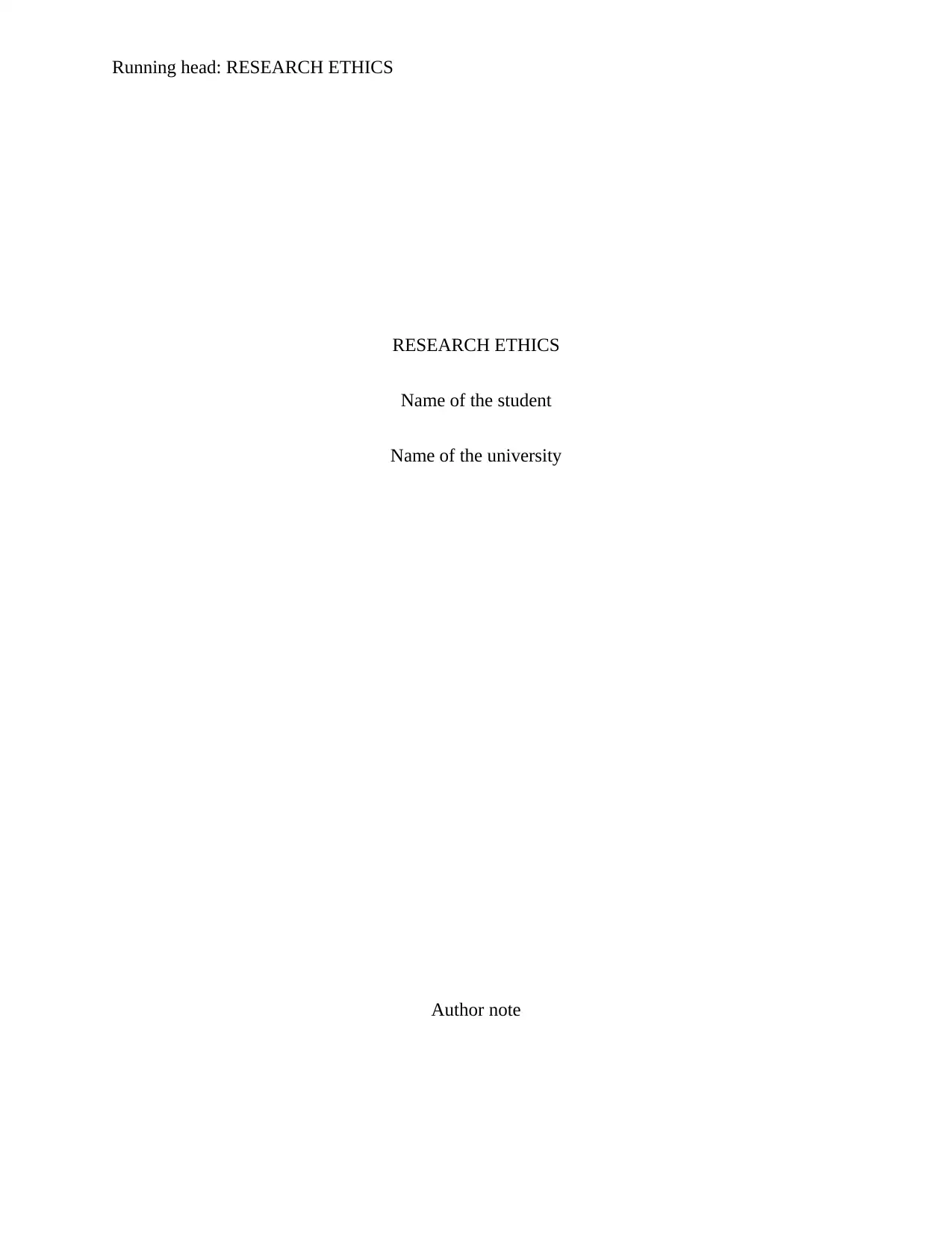
Running head: RESEARCH ETHICS
RESEARCH ETHICS
Name of the student
Name of the university
Author note
RESEARCH ETHICS
Name of the student
Name of the university
Author note
Paraphrase This Document
Need a fresh take? Get an instant paraphrase of this document with our AI Paraphraser
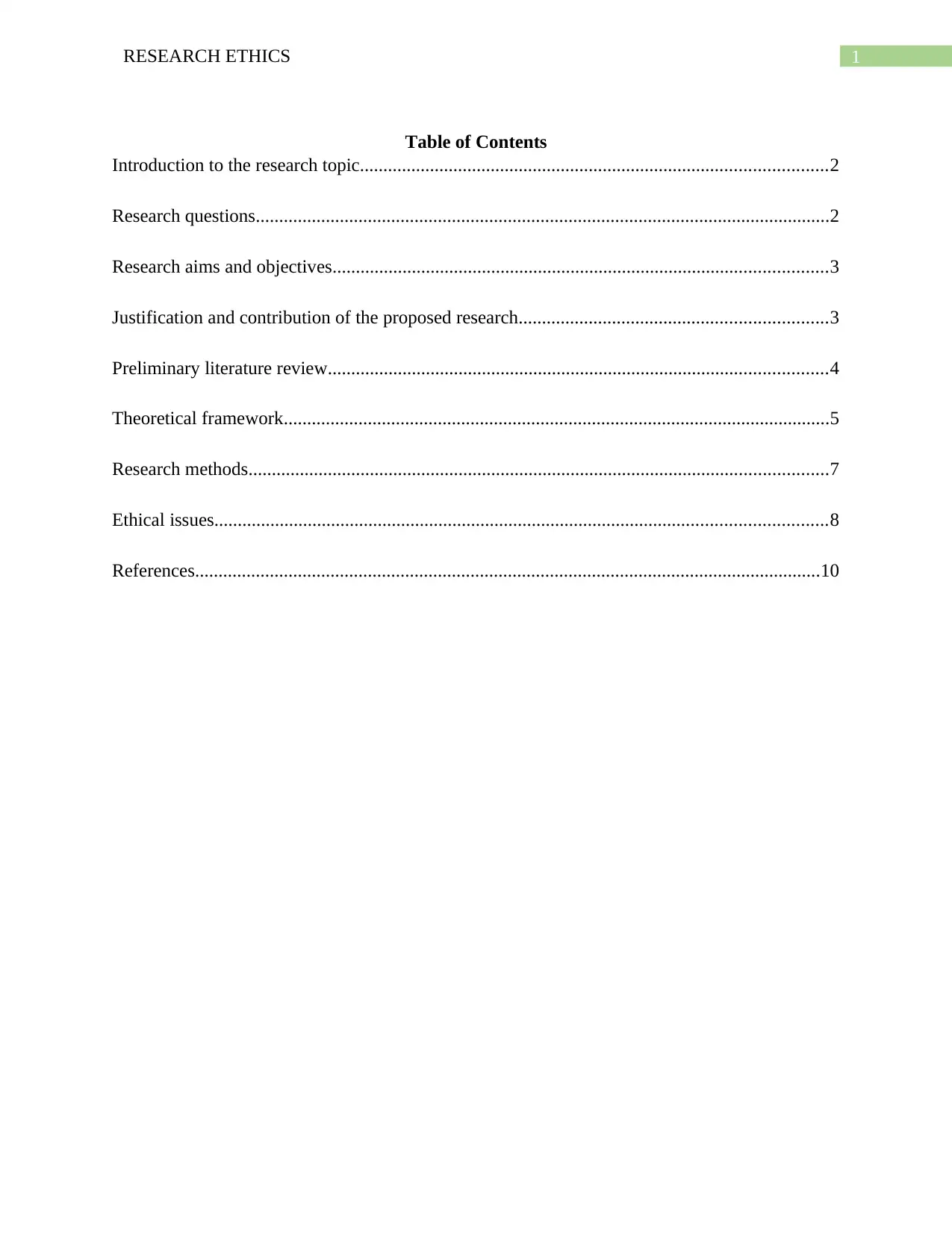
1RESEARCH ETHICS
Table of Contents
Introduction to the research topic....................................................................................................2
Research questions...........................................................................................................................2
Research aims and objectives..........................................................................................................3
Justification and contribution of the proposed research..................................................................3
Preliminary literature review...........................................................................................................4
Theoretical framework.....................................................................................................................5
Research methods............................................................................................................................7
Ethical issues...................................................................................................................................8
References......................................................................................................................................10
Table of Contents
Introduction to the research topic....................................................................................................2
Research questions...........................................................................................................................2
Research aims and objectives..........................................................................................................3
Justification and contribution of the proposed research..................................................................3
Preliminary literature review...........................................................................................................4
Theoretical framework.....................................................................................................................5
Research methods............................................................................................................................7
Ethical issues...................................................................................................................................8
References......................................................................................................................................10
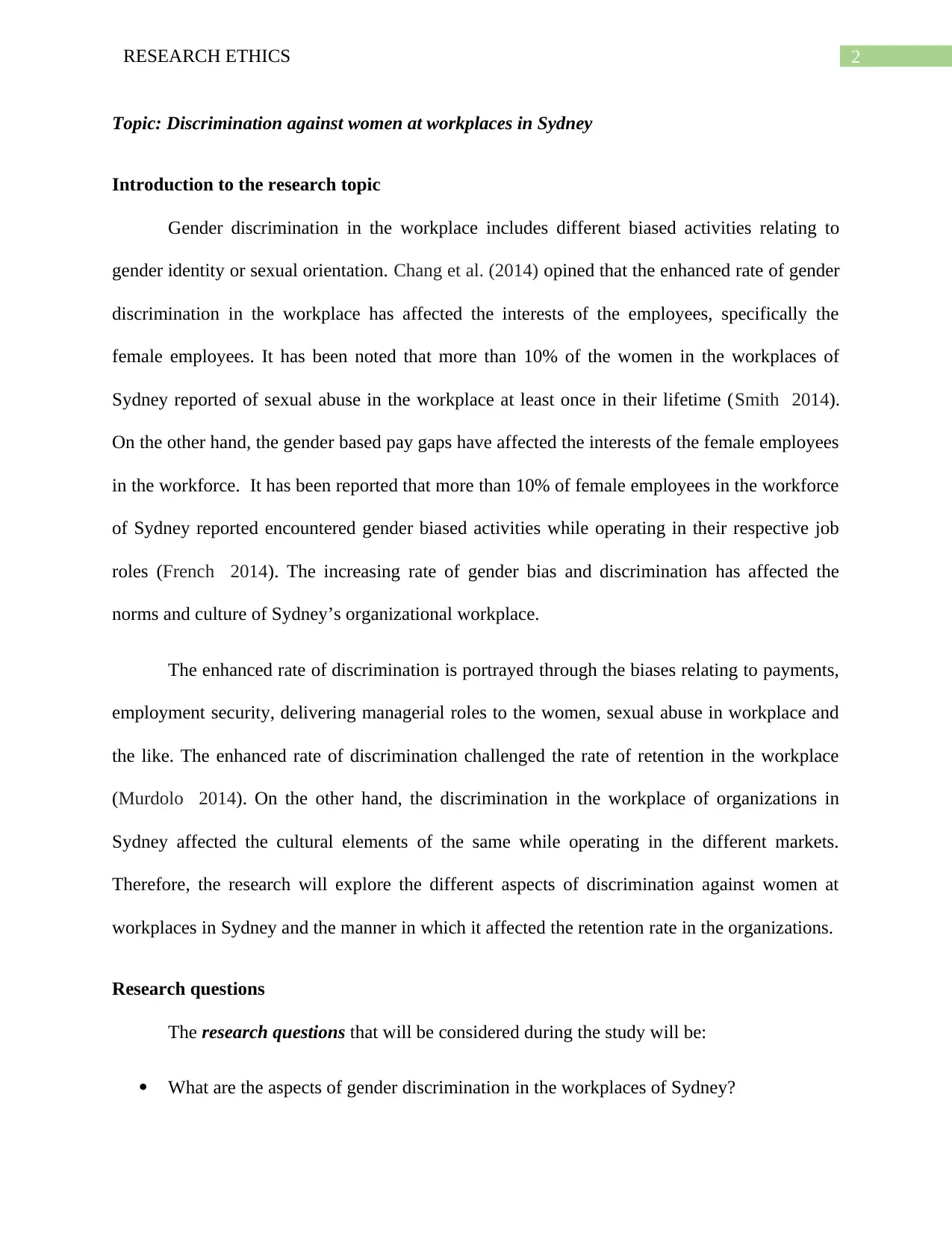
2RESEARCH ETHICS
Topic: Discrimination against women at workplaces in Sydney
Introduction to the research topic
Gender discrimination in the workplace includes different biased activities relating to
gender identity or sexual orientation. Chang et al. (2014) opined that the enhanced rate of gender
discrimination in the workplace has affected the interests of the employees, specifically the
female employees. It has been noted that more than 10% of the women in the workplaces of
Sydney reported of sexual abuse in the workplace at least once in their lifetime (Smith 2014).
On the other hand, the gender based pay gaps have affected the interests of the female employees
in the workforce. It has been reported that more than 10% of female employees in the workforce
of Sydney reported encountered gender biased activities while operating in their respective job
roles (French 2014). The increasing rate of gender bias and discrimination has affected the
norms and culture of Sydney’s organizational workplace.
The enhanced rate of discrimination is portrayed through the biases relating to payments,
employment security, delivering managerial roles to the women, sexual abuse in workplace and
the like. The enhanced rate of discrimination challenged the rate of retention in the workplace
(Murdolo 2014). On the other hand, the discrimination in the workplace of organizations in
Sydney affected the cultural elements of the same while operating in the different markets.
Therefore, the research will explore the different aspects of discrimination against women at
workplaces in Sydney and the manner in which it affected the retention rate in the organizations.
Research questions
The research questions that will be considered during the study will be:
What are the aspects of gender discrimination in the workplaces of Sydney?
Topic: Discrimination against women at workplaces in Sydney
Introduction to the research topic
Gender discrimination in the workplace includes different biased activities relating to
gender identity or sexual orientation. Chang et al. (2014) opined that the enhanced rate of gender
discrimination in the workplace has affected the interests of the employees, specifically the
female employees. It has been noted that more than 10% of the women in the workplaces of
Sydney reported of sexual abuse in the workplace at least once in their lifetime (Smith 2014).
On the other hand, the gender based pay gaps have affected the interests of the female employees
in the workforce. It has been reported that more than 10% of female employees in the workforce
of Sydney reported encountered gender biased activities while operating in their respective job
roles (French 2014). The increasing rate of gender bias and discrimination has affected the
norms and culture of Sydney’s organizational workplace.
The enhanced rate of discrimination is portrayed through the biases relating to payments,
employment security, delivering managerial roles to the women, sexual abuse in workplace and
the like. The enhanced rate of discrimination challenged the rate of retention in the workplace
(Murdolo 2014). On the other hand, the discrimination in the workplace of organizations in
Sydney affected the cultural elements of the same while operating in the different markets.
Therefore, the research will explore the different aspects of discrimination against women at
workplaces in Sydney and the manner in which it affected the retention rate in the organizations.
Research questions
The research questions that will be considered during the study will be:
What are the aspects of gender discrimination in the workplaces of Sydney?
⊘ This is a preview!⊘
Do you want full access?
Subscribe today to unlock all pages.

Trusted by 1+ million students worldwide
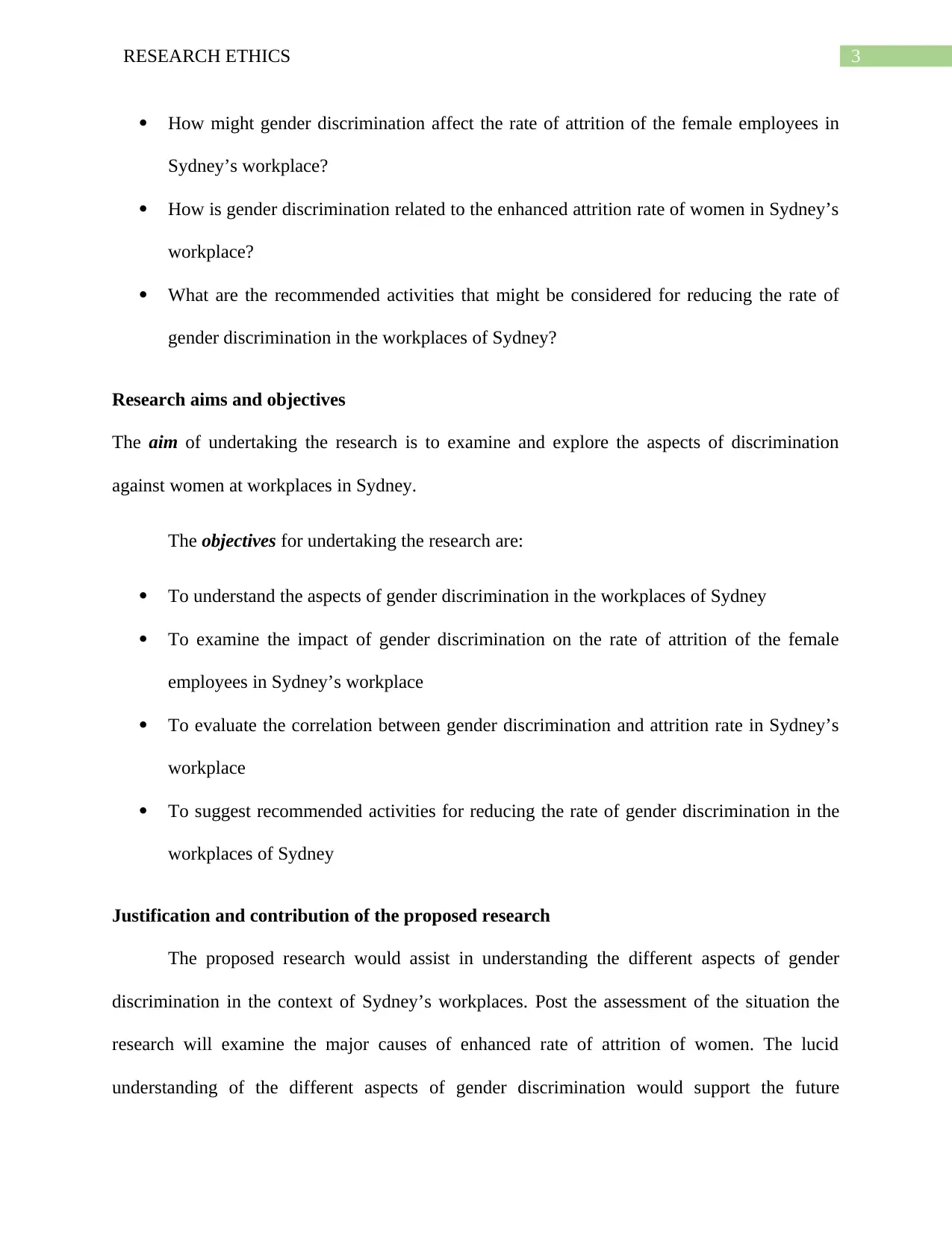
3RESEARCH ETHICS
How might gender discrimination affect the rate of attrition of the female employees in
Sydney’s workplace?
How is gender discrimination related to the enhanced attrition rate of women in Sydney’s
workplace?
What are the recommended activities that might be considered for reducing the rate of
gender discrimination in the workplaces of Sydney?
Research aims and objectives
The aim of undertaking the research is to examine and explore the aspects of discrimination
against women at workplaces in Sydney.
The objectives for undertaking the research are:
To understand the aspects of gender discrimination in the workplaces of Sydney
To examine the impact of gender discrimination on the rate of attrition of the female
employees in Sydney’s workplace
To evaluate the correlation between gender discrimination and attrition rate in Sydney’s
workplace
To suggest recommended activities for reducing the rate of gender discrimination in the
workplaces of Sydney
Justification and contribution of the proposed research
The proposed research would assist in understanding the different aspects of gender
discrimination in the context of Sydney’s workplaces. Post the assessment of the situation the
research will examine the major causes of enhanced rate of attrition of women. The lucid
understanding of the different aspects of gender discrimination would support the future
How might gender discrimination affect the rate of attrition of the female employees in
Sydney’s workplace?
How is gender discrimination related to the enhanced attrition rate of women in Sydney’s
workplace?
What are the recommended activities that might be considered for reducing the rate of
gender discrimination in the workplaces of Sydney?
Research aims and objectives
The aim of undertaking the research is to examine and explore the aspects of discrimination
against women at workplaces in Sydney.
The objectives for undertaking the research are:
To understand the aspects of gender discrimination in the workplaces of Sydney
To examine the impact of gender discrimination on the rate of attrition of the female
employees in Sydney’s workplace
To evaluate the correlation between gender discrimination and attrition rate in Sydney’s
workplace
To suggest recommended activities for reducing the rate of gender discrimination in the
workplaces of Sydney
Justification and contribution of the proposed research
The proposed research would assist in understanding the different aspects of gender
discrimination in the context of Sydney’s workplaces. Post the assessment of the situation the
research will examine the major causes of enhanced rate of attrition of women. The lucid
understanding of the different aspects of gender discrimination would support the future
Paraphrase This Document
Need a fresh take? Get an instant paraphrase of this document with our AI Paraphraser
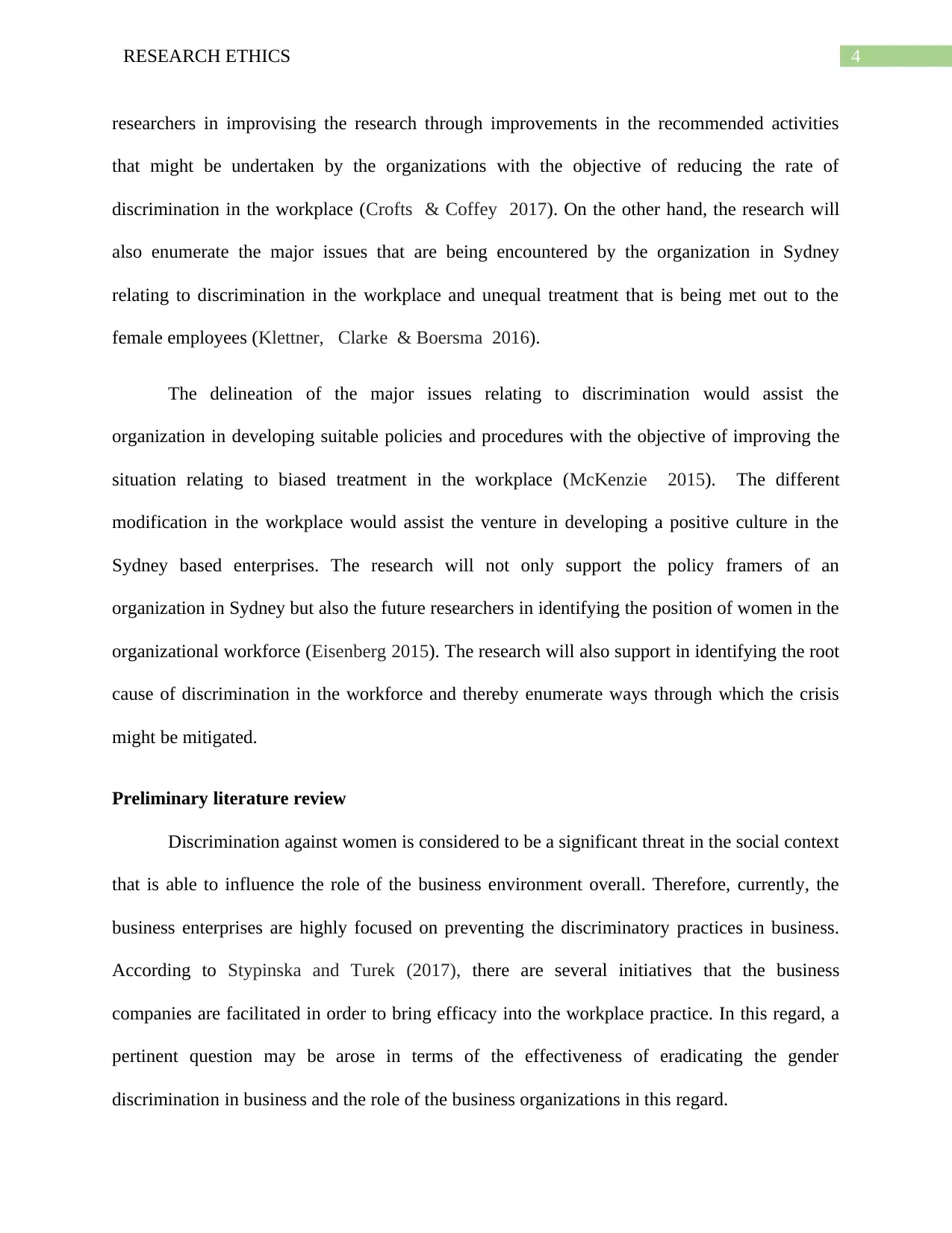
4RESEARCH ETHICS
researchers in improvising the research through improvements in the recommended activities
that might be undertaken by the organizations with the objective of reducing the rate of
discrimination in the workplace (Crofts & Coffey 2017). On the other hand, the research will
also enumerate the major issues that are being encountered by the organization in Sydney
relating to discrimination in the workplace and unequal treatment that is being met out to the
female employees (Klettner, Clarke & Boersma 2016).
The delineation of the major issues relating to discrimination would assist the
organization in developing suitable policies and procedures with the objective of improving the
situation relating to biased treatment in the workplace (McKenzie 2015). The different
modification in the workplace would assist the venture in developing a positive culture in the
Sydney based enterprises. The research will not only support the policy framers of an
organization in Sydney but also the future researchers in identifying the position of women in the
organizational workforce (Eisenberg 2015). The research will also support in identifying the root
cause of discrimination in the workforce and thereby enumerate ways through which the crisis
might be mitigated.
Preliminary literature review
Discrimination against women is considered to be a significant threat in the social context
that is able to influence the role of the business environment overall. Therefore, currently, the
business enterprises are highly focused on preventing the discriminatory practices in business.
According to Stypinska and Turek (2017), there are several initiatives that the business
companies are facilitated in order to bring efficacy into the workplace practice. In this regard, a
pertinent question may be arose in terms of the effectiveness of eradicating the gender
discrimination in business and the role of the business organizations in this regard.
researchers in improvising the research through improvements in the recommended activities
that might be undertaken by the organizations with the objective of reducing the rate of
discrimination in the workplace (Crofts & Coffey 2017). On the other hand, the research will
also enumerate the major issues that are being encountered by the organization in Sydney
relating to discrimination in the workplace and unequal treatment that is being met out to the
female employees (Klettner, Clarke & Boersma 2016).
The delineation of the major issues relating to discrimination would assist the
organization in developing suitable policies and procedures with the objective of improving the
situation relating to biased treatment in the workplace (McKenzie 2015). The different
modification in the workplace would assist the venture in developing a positive culture in the
Sydney based enterprises. The research will not only support the policy framers of an
organization in Sydney but also the future researchers in identifying the position of women in the
organizational workforce (Eisenberg 2015). The research will also support in identifying the root
cause of discrimination in the workforce and thereby enumerate ways through which the crisis
might be mitigated.
Preliminary literature review
Discrimination against women is considered to be a significant threat in the social context
that is able to influence the role of the business environment overall. Therefore, currently, the
business enterprises are highly focused on preventing the discriminatory practices in business.
According to Stypinska and Turek (2017), there are several initiatives that the business
companies are facilitated in order to bring efficacy into the workplace practice. In this regard, a
pertinent question may be arose in terms of the effectiveness of eradicating the gender
discrimination in business and the role of the business organizations in this regard.
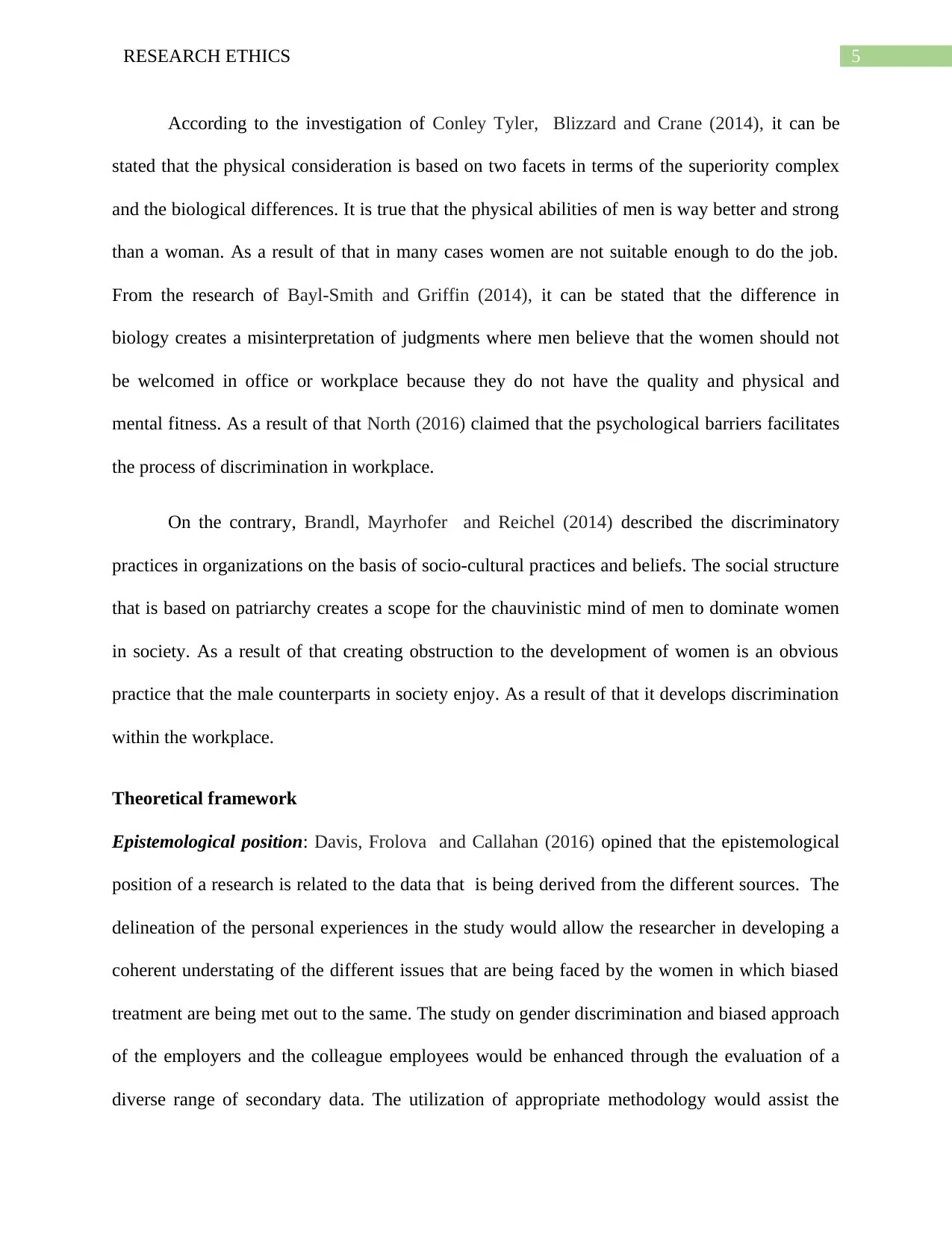
5RESEARCH ETHICS
According to the investigation of Conley Tyler, Blizzard and Crane (2014), it can be
stated that the physical consideration is based on two facets in terms of the superiority complex
and the biological differences. It is true that the physical abilities of men is way better and strong
than a woman. As a result of that in many cases women are not suitable enough to do the job.
From the research of Bayl‐Smith and Griffin (2014), it can be stated that the difference in
biology creates a misinterpretation of judgments where men believe that the women should not
be welcomed in office or workplace because they do not have the quality and physical and
mental fitness. As a result of that North (2016) claimed that the psychological barriers facilitates
the process of discrimination in workplace.
On the contrary, Brandl, Mayrhofer and Reichel (2014) described the discriminatory
practices in organizations on the basis of socio-cultural practices and beliefs. The social structure
that is based on patriarchy creates a scope for the chauvinistic mind of men to dominate women
in society. As a result of that creating obstruction to the development of women is an obvious
practice that the male counterparts in society enjoy. As a result of that it develops discrimination
within the workplace.
Theoretical framework
Epistemological position: Davis, Frolova and Callahan (2016) opined that the epistemological
position of a research is related to the data that is being derived from the different sources. The
delineation of the personal experiences in the study would allow the researcher in developing a
coherent understating of the different issues that are being faced by the women in which biased
treatment are being met out to the same. The study on gender discrimination and biased approach
of the employers and the colleague employees would be enhanced through the evaluation of a
diverse range of secondary data. The utilization of appropriate methodology would assist the
According to the investigation of Conley Tyler, Blizzard and Crane (2014), it can be
stated that the physical consideration is based on two facets in terms of the superiority complex
and the biological differences. It is true that the physical abilities of men is way better and strong
than a woman. As a result of that in many cases women are not suitable enough to do the job.
From the research of Bayl‐Smith and Griffin (2014), it can be stated that the difference in
biology creates a misinterpretation of judgments where men believe that the women should not
be welcomed in office or workplace because they do not have the quality and physical and
mental fitness. As a result of that North (2016) claimed that the psychological barriers facilitates
the process of discrimination in workplace.
On the contrary, Brandl, Mayrhofer and Reichel (2014) described the discriminatory
practices in organizations on the basis of socio-cultural practices and beliefs. The social structure
that is based on patriarchy creates a scope for the chauvinistic mind of men to dominate women
in society. As a result of that creating obstruction to the development of women is an obvious
practice that the male counterparts in society enjoy. As a result of that it develops discrimination
within the workplace.
Theoretical framework
Epistemological position: Davis, Frolova and Callahan (2016) opined that the epistemological
position of a research is related to the data that is being derived from the different sources. The
delineation of the personal experiences in the study would allow the researcher in developing a
coherent understating of the different issues that are being faced by the women in which biased
treatment are being met out to the same. The study on gender discrimination and biased approach
of the employers and the colleague employees would be enhanced through the evaluation of a
diverse range of secondary data. The utilization of appropriate methodology would assist the
⊘ This is a preview!⊘
Do you want full access?
Subscribe today to unlock all pages.

Trusted by 1+ million students worldwide
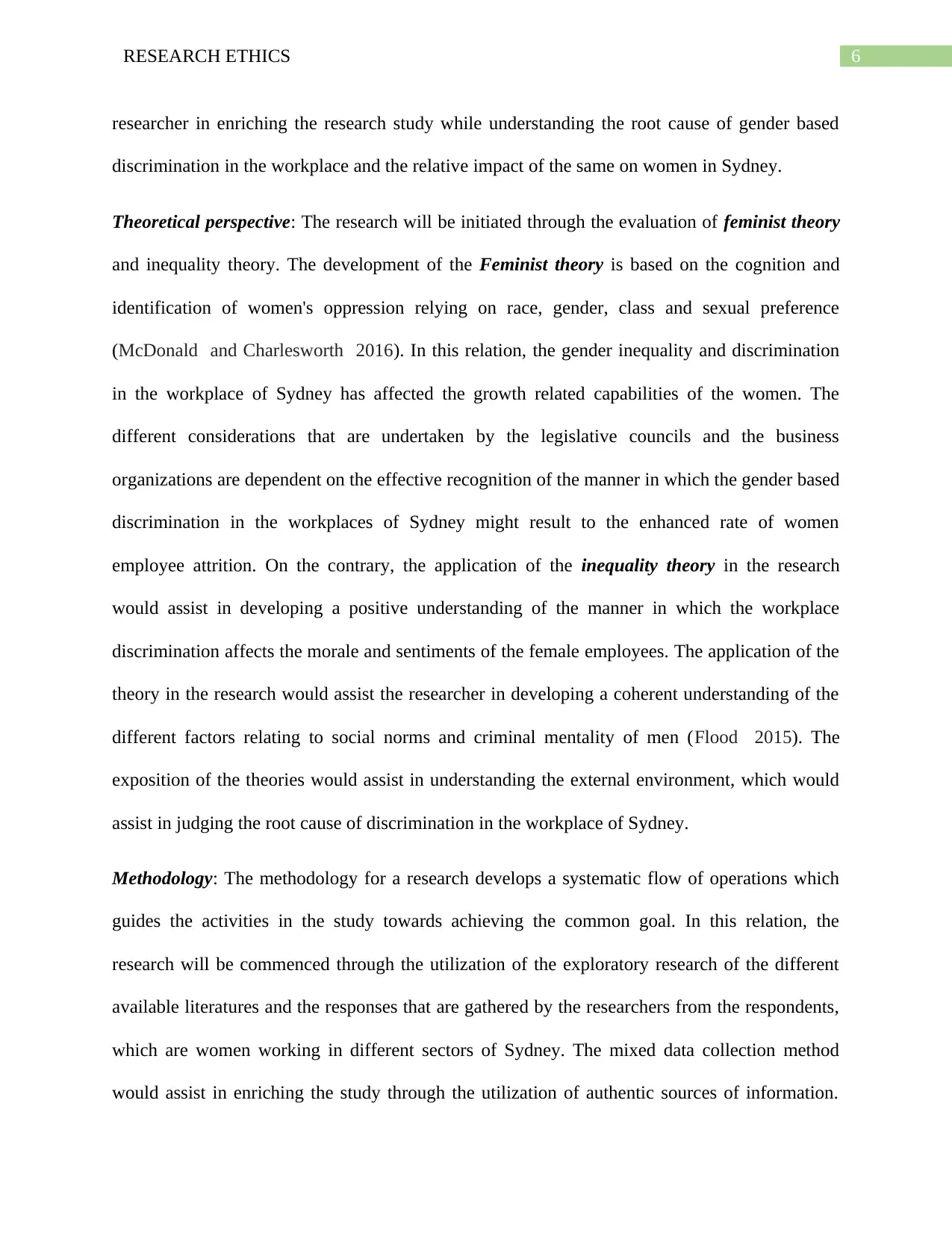
6RESEARCH ETHICS
researcher in enriching the research study while understanding the root cause of gender based
discrimination in the workplace and the relative impact of the same on women in Sydney.
Theoretical perspective: The research will be initiated through the evaluation of feminist theory
and inequality theory. The development of the Feminist theory is based on the cognition and
identification of women's oppression relying on race, gender, class and sexual preference
(McDonald and Charlesworth 2016). In this relation, the gender inequality and discrimination
in the workplace of Sydney has affected the growth related capabilities of the women. The
different considerations that are undertaken by the legislative councils and the business
organizations are dependent on the effective recognition of the manner in which the gender based
discrimination in the workplaces of Sydney might result to the enhanced rate of women
employee attrition. On the contrary, the application of the inequality theory in the research
would assist in developing a positive understanding of the manner in which the workplace
discrimination affects the morale and sentiments of the female employees. The application of the
theory in the research would assist the researcher in developing a coherent understanding of the
different factors relating to social norms and criminal mentality of men (Flood 2015). The
exposition of the theories would assist in understanding the external environment, which would
assist in judging the root cause of discrimination in the workplace of Sydney.
Methodology: The methodology for a research develops a systematic flow of operations which
guides the activities in the study towards achieving the common goal. In this relation, the
research will be commenced through the utilization of the exploratory research of the different
available literatures and the responses that are gathered by the researchers from the respondents,
which are women working in different sectors of Sydney. The mixed data collection method
would assist in enriching the study through the utilization of authentic sources of information.
researcher in enriching the research study while understanding the root cause of gender based
discrimination in the workplace and the relative impact of the same on women in Sydney.
Theoretical perspective: The research will be initiated through the evaluation of feminist theory
and inequality theory. The development of the Feminist theory is based on the cognition and
identification of women's oppression relying on race, gender, class and sexual preference
(McDonald and Charlesworth 2016). In this relation, the gender inequality and discrimination
in the workplace of Sydney has affected the growth related capabilities of the women. The
different considerations that are undertaken by the legislative councils and the business
organizations are dependent on the effective recognition of the manner in which the gender based
discrimination in the workplaces of Sydney might result to the enhanced rate of women
employee attrition. On the contrary, the application of the inequality theory in the research
would assist in developing a positive understanding of the manner in which the workplace
discrimination affects the morale and sentiments of the female employees. The application of the
theory in the research would assist the researcher in developing a coherent understanding of the
different factors relating to social norms and criminal mentality of men (Flood 2015). The
exposition of the theories would assist in understanding the external environment, which would
assist in judging the root cause of discrimination in the workplace of Sydney.
Methodology: The methodology for a research develops a systematic flow of operations which
guides the activities in the study towards achieving the common goal. In this relation, the
research will be commenced through the utilization of the exploratory research of the different
available literatures and the responses that are gathered by the researchers from the respondents,
which are women working in different sectors of Sydney. The mixed data collection method
would assist in enriching the study through the utilization of authentic sources of information.
Paraphrase This Document
Need a fresh take? Get an instant paraphrase of this document with our AI Paraphraser
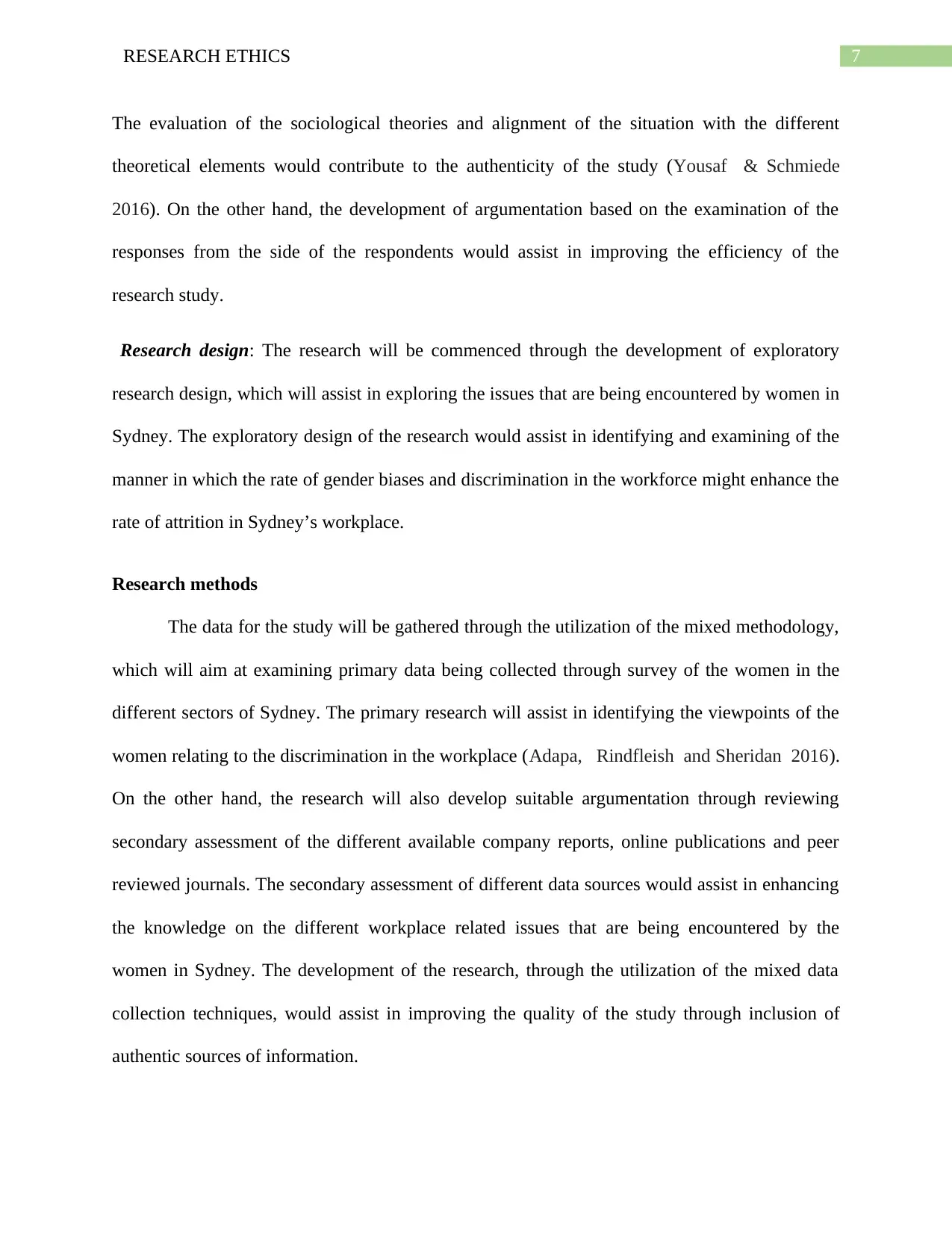
7RESEARCH ETHICS
The evaluation of the sociological theories and alignment of the situation with the different
theoretical elements would contribute to the authenticity of the study (Yousaf & Schmiede
2016). On the other hand, the development of argumentation based on the examination of the
responses from the side of the respondents would assist in improving the efficiency of the
research study.
Research design: The research will be commenced through the development of exploratory
research design, which will assist in exploring the issues that are being encountered by women in
Sydney. The exploratory design of the research would assist in identifying and examining of the
manner in which the rate of gender biases and discrimination in the workforce might enhance the
rate of attrition in Sydney’s workplace.
Research methods
The data for the study will be gathered through the utilization of the mixed methodology,
which will aim at examining primary data being collected through survey of the women in the
different sectors of Sydney. The primary research will assist in identifying the viewpoints of the
women relating to the discrimination in the workplace (Adapa, Rindfleish and Sheridan 2016).
On the other hand, the research will also develop suitable argumentation through reviewing
secondary assessment of the different available company reports, online publications and peer
reviewed journals. The secondary assessment of different data sources would assist in enhancing
the knowledge on the different workplace related issues that are being encountered by the
women in Sydney. The development of the research, through the utilization of the mixed data
collection techniques, would assist in improving the quality of the study through inclusion of
authentic sources of information.
The evaluation of the sociological theories and alignment of the situation with the different
theoretical elements would contribute to the authenticity of the study (Yousaf & Schmiede
2016). On the other hand, the development of argumentation based on the examination of the
responses from the side of the respondents would assist in improving the efficiency of the
research study.
Research design: The research will be commenced through the development of exploratory
research design, which will assist in exploring the issues that are being encountered by women in
Sydney. The exploratory design of the research would assist in identifying and examining of the
manner in which the rate of gender biases and discrimination in the workforce might enhance the
rate of attrition in Sydney’s workplace.
Research methods
The data for the study will be gathered through the utilization of the mixed methodology,
which will aim at examining primary data being collected through survey of the women in the
different sectors of Sydney. The primary research will assist in identifying the viewpoints of the
women relating to the discrimination in the workplace (Adapa, Rindfleish and Sheridan 2016).
On the other hand, the research will also develop suitable argumentation through reviewing
secondary assessment of the different available company reports, online publications and peer
reviewed journals. The secondary assessment of different data sources would assist in enhancing
the knowledge on the different workplace related issues that are being encountered by the
women in Sydney. The development of the research, through the utilization of the mixed data
collection techniques, would assist in improving the quality of the study through inclusion of
authentic sources of information.
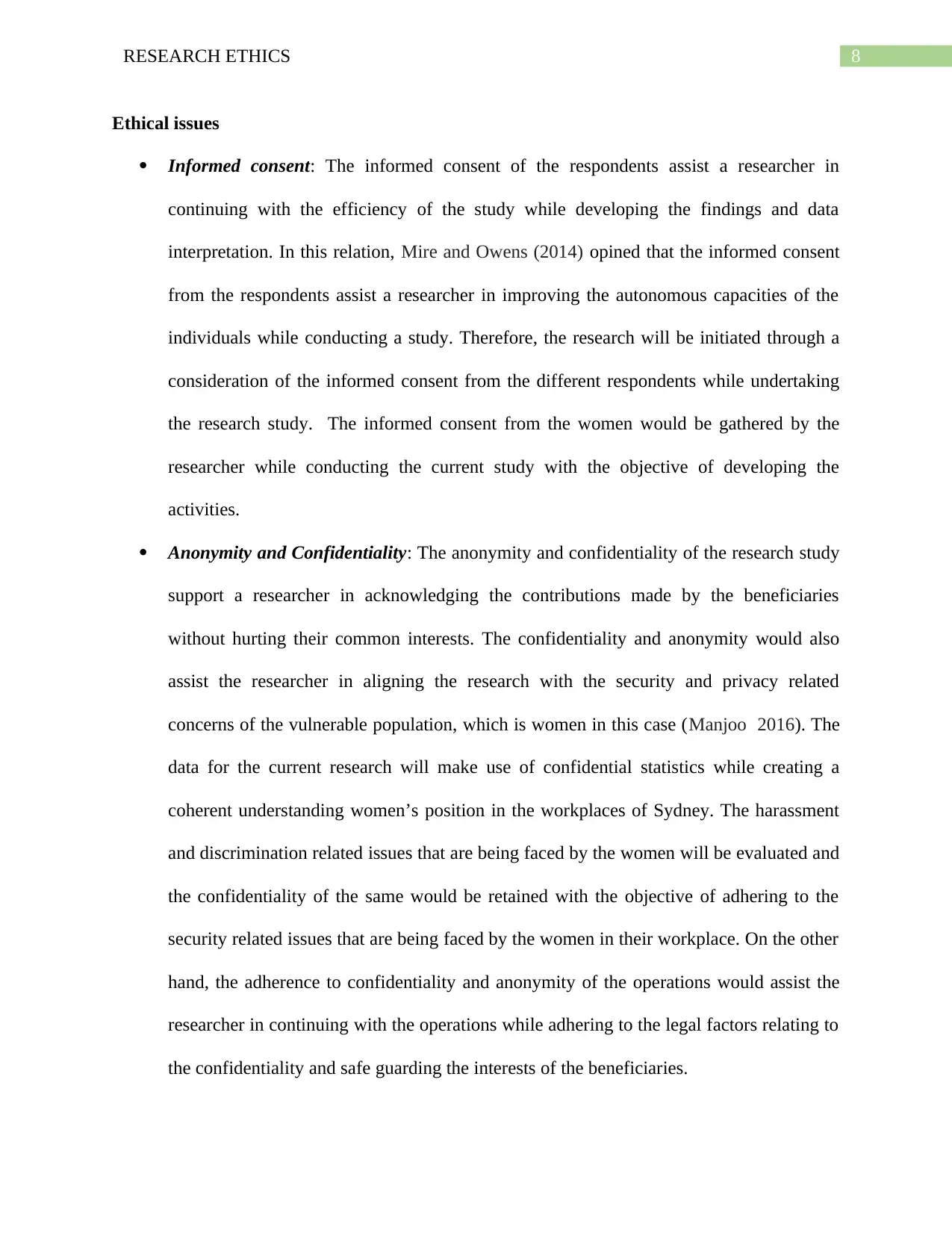
8RESEARCH ETHICS
Ethical issues
Informed consent: The informed consent of the respondents assist a researcher in
continuing with the efficiency of the study while developing the findings and data
interpretation. In this relation, Mire and Owens (2014) opined that the informed consent
from the respondents assist a researcher in improving the autonomous capacities of the
individuals while conducting a study. Therefore, the research will be initiated through a
consideration of the informed consent from the different respondents while undertaking
the research study. The informed consent from the women would be gathered by the
researcher while conducting the current study with the objective of developing the
activities.
Anonymity and Confidentiality: The anonymity and confidentiality of the research study
support a researcher in acknowledging the contributions made by the beneficiaries
without hurting their common interests. The confidentiality and anonymity would also
assist the researcher in aligning the research with the security and privacy related
concerns of the vulnerable population, which is women in this case (Manjoo 2016). The
data for the current research will make use of confidential statistics while creating a
coherent understanding women’s position in the workplaces of Sydney. The harassment
and discrimination related issues that are being faced by the women will be evaluated and
the confidentiality of the same would be retained with the objective of adhering to the
security related issues that are being faced by the women in their workplace. On the other
hand, the adherence to confidentiality and anonymity of the operations would assist the
researcher in continuing with the operations while adhering to the legal factors relating to
the confidentiality and safe guarding the interests of the beneficiaries.
Ethical issues
Informed consent: The informed consent of the respondents assist a researcher in
continuing with the efficiency of the study while developing the findings and data
interpretation. In this relation, Mire and Owens (2014) opined that the informed consent
from the respondents assist a researcher in improving the autonomous capacities of the
individuals while conducting a study. Therefore, the research will be initiated through a
consideration of the informed consent from the different respondents while undertaking
the research study. The informed consent from the women would be gathered by the
researcher while conducting the current study with the objective of developing the
activities.
Anonymity and Confidentiality: The anonymity and confidentiality of the research study
support a researcher in acknowledging the contributions made by the beneficiaries
without hurting their common interests. The confidentiality and anonymity would also
assist the researcher in aligning the research with the security and privacy related
concerns of the vulnerable population, which is women in this case (Manjoo 2016). The
data for the current research will make use of confidential statistics while creating a
coherent understanding women’s position in the workplaces of Sydney. The harassment
and discrimination related issues that are being faced by the women will be evaluated and
the confidentiality of the same would be retained with the objective of adhering to the
security related issues that are being faced by the women in their workplace. On the other
hand, the adherence to confidentiality and anonymity of the operations would assist the
researcher in continuing with the operations while adhering to the legal factors relating to
the confidentiality and safe guarding the interests of the beneficiaries.
⊘ This is a preview!⊘
Do you want full access?
Subscribe today to unlock all pages.

Trusted by 1+ million students worldwide

9RESEARCH ETHICS
Paraphrase This Document
Need a fresh take? Get an instant paraphrase of this document with our AI Paraphraser
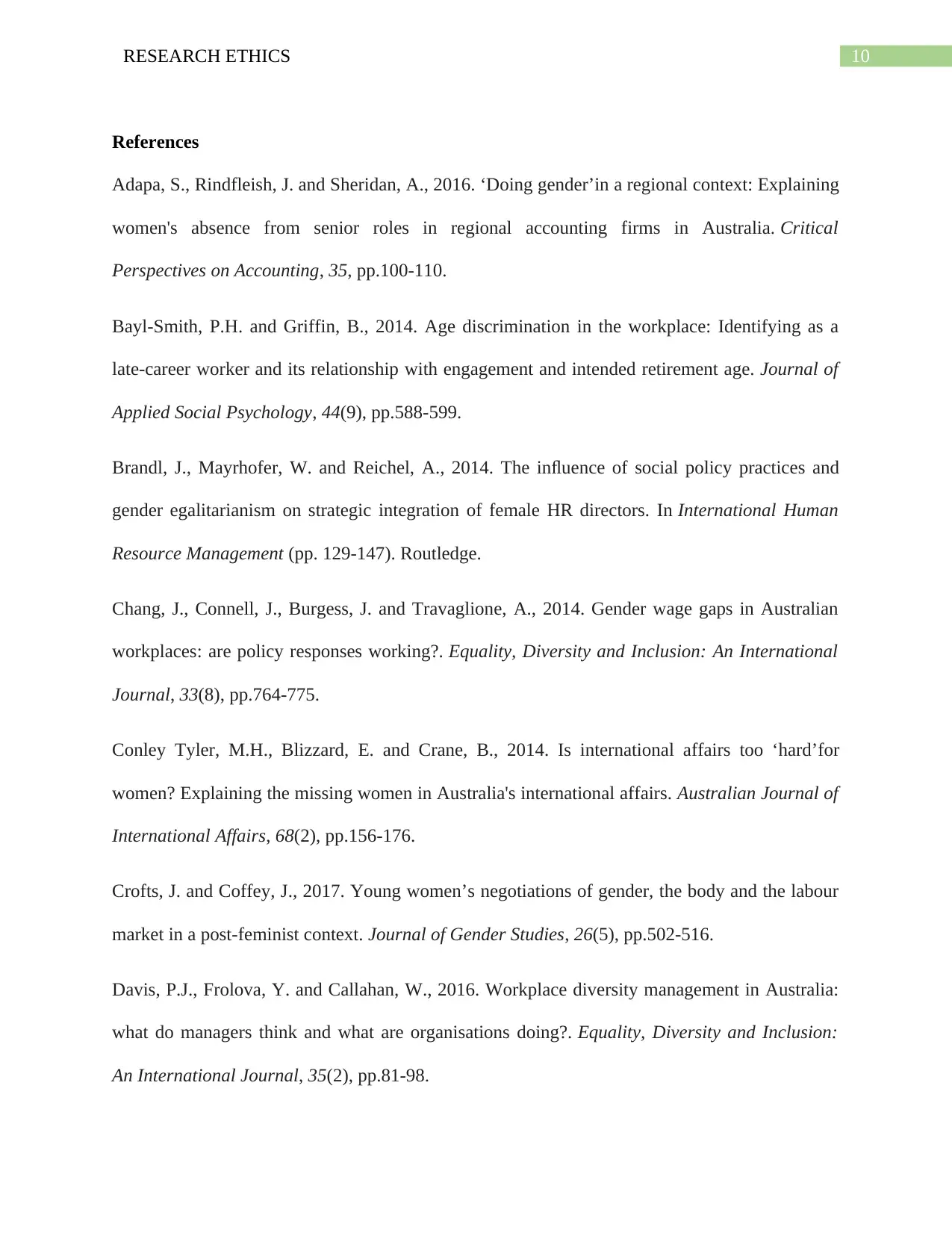
10RESEARCH ETHICS
References
Adapa, S., Rindfleish, J. and Sheridan, A., 2016. ‘Doing gender’in a regional context: Explaining
women's absence from senior roles in regional accounting firms in Australia. Critical
Perspectives on Accounting, 35, pp.100-110.
Bayl‐Smith, P.H. and Griffin, B., 2014. Age discrimination in the workplace: Identifying as a
late‐career worker and its relationship with engagement and intended retirement age. Journal of
Applied Social Psychology, 44(9), pp.588-599.
Brandl, J., Mayrhofer, W. and Reichel, A., 2014. The influence of social policy practices and
gender egalitarianism on strategic integration of female HR directors. In International Human
Resource Management (pp. 129-147). Routledge.
Chang, J., Connell, J., Burgess, J. and Travaglione, A., 2014. Gender wage gaps in Australian
workplaces: are policy responses working?. Equality, Diversity and Inclusion: An International
Journal, 33(8), pp.764-775.
Conley Tyler, M.H., Blizzard, E. and Crane, B., 2014. Is international affairs too ‘hard’for
women? Explaining the missing women in Australia's international affairs. Australian Journal of
International Affairs, 68(2), pp.156-176.
Crofts, J. and Coffey, J., 2017. Young women’s negotiations of gender, the body and the labour
market in a post-feminist context. Journal of Gender Studies, 26(5), pp.502-516.
Davis, P.J., Frolova, Y. and Callahan, W., 2016. Workplace diversity management in Australia:
what do managers think and what are organisations doing?. Equality, Diversity and Inclusion:
An International Journal, 35(2), pp.81-98.
References
Adapa, S., Rindfleish, J. and Sheridan, A., 2016. ‘Doing gender’in a regional context: Explaining
women's absence from senior roles in regional accounting firms in Australia. Critical
Perspectives on Accounting, 35, pp.100-110.
Bayl‐Smith, P.H. and Griffin, B., 2014. Age discrimination in the workplace: Identifying as a
late‐career worker and its relationship with engagement and intended retirement age. Journal of
Applied Social Psychology, 44(9), pp.588-599.
Brandl, J., Mayrhofer, W. and Reichel, A., 2014. The influence of social policy practices and
gender egalitarianism on strategic integration of female HR directors. In International Human
Resource Management (pp. 129-147). Routledge.
Chang, J., Connell, J., Burgess, J. and Travaglione, A., 2014. Gender wage gaps in Australian
workplaces: are policy responses working?. Equality, Diversity and Inclusion: An International
Journal, 33(8), pp.764-775.
Conley Tyler, M.H., Blizzard, E. and Crane, B., 2014. Is international affairs too ‘hard’for
women? Explaining the missing women in Australia's international affairs. Australian Journal of
International Affairs, 68(2), pp.156-176.
Crofts, J. and Coffey, J., 2017. Young women’s negotiations of gender, the body and the labour
market in a post-feminist context. Journal of Gender Studies, 26(5), pp.502-516.
Davis, P.J., Frolova, Y. and Callahan, W., 2016. Workplace diversity management in Australia:
what do managers think and what are organisations doing?. Equality, Diversity and Inclusion:
An International Journal, 35(2), pp.81-98.
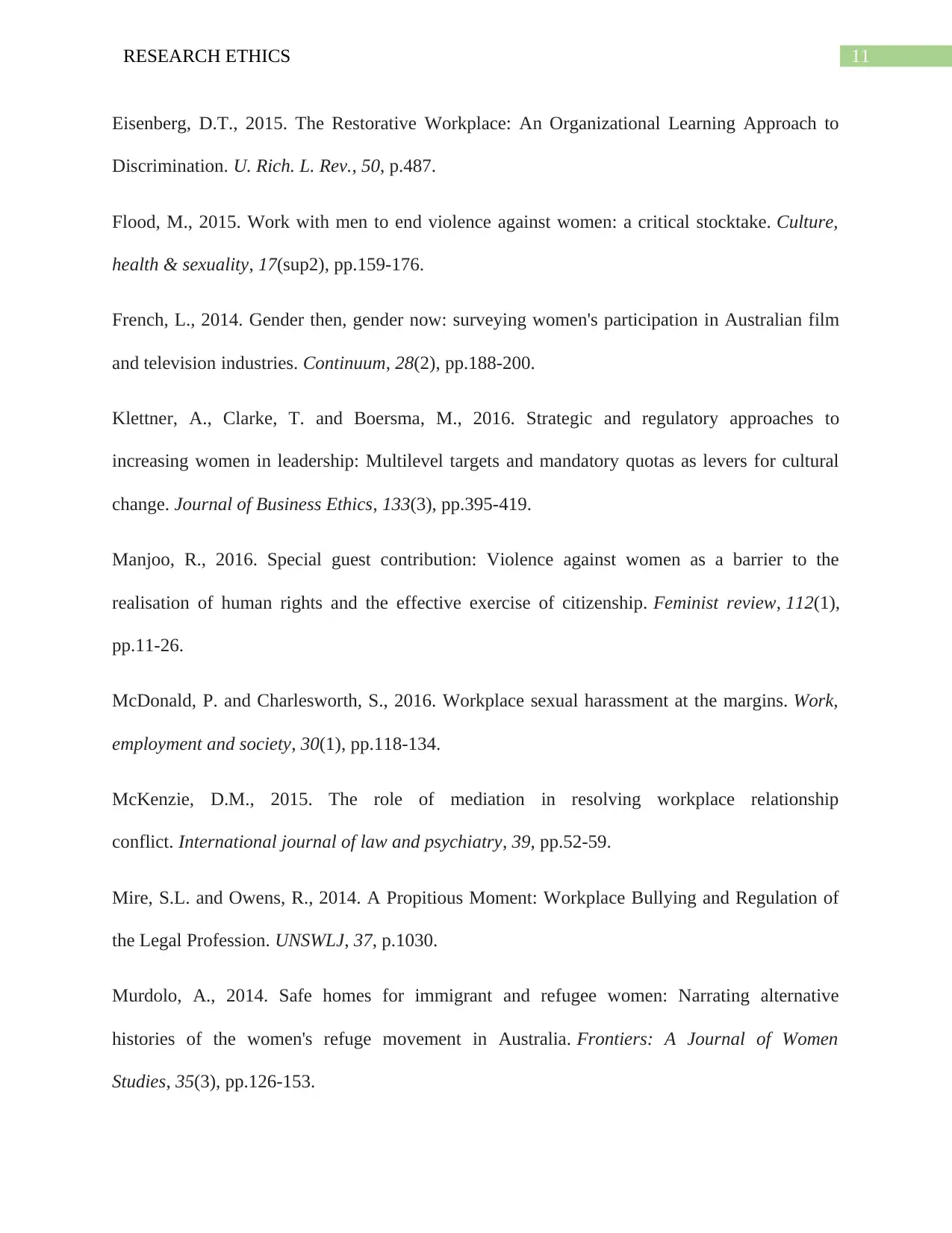
11RESEARCH ETHICS
Eisenberg, D.T., 2015. The Restorative Workplace: An Organizational Learning Approach to
Discrimination. U. Rich. L. Rev., 50, p.487.
Flood, M., 2015. Work with men to end violence against women: a critical stocktake. Culture,
health & sexuality, 17(sup2), pp.159-176.
French, L., 2014. Gender then, gender now: surveying women's participation in Australian film
and television industries. Continuum, 28(2), pp.188-200.
Klettner, A., Clarke, T. and Boersma, M., 2016. Strategic and regulatory approaches to
increasing women in leadership: Multilevel targets and mandatory quotas as levers for cultural
change. Journal of Business Ethics, 133(3), pp.395-419.
Manjoo, R., 2016. Special guest contribution: Violence against women as a barrier to the
realisation of human rights and the effective exercise of citizenship. Feminist review, 112(1),
pp.11-26.
McDonald, P. and Charlesworth, S., 2016. Workplace sexual harassment at the margins. Work,
employment and society, 30(1), pp.118-134.
McKenzie, D.M., 2015. The role of mediation in resolving workplace relationship
conflict. International journal of law and psychiatry, 39, pp.52-59.
Mire, S.L. and Owens, R., 2014. A Propitious Moment: Workplace Bullying and Regulation of
the Legal Profession. UNSWLJ, 37, p.1030.
Murdolo, A., 2014. Safe homes for immigrant and refugee women: Narrating alternative
histories of the women's refuge movement in Australia. Frontiers: A Journal of Women
Studies, 35(3), pp.126-153.
Eisenberg, D.T., 2015. The Restorative Workplace: An Organizational Learning Approach to
Discrimination. U. Rich. L. Rev., 50, p.487.
Flood, M., 2015. Work with men to end violence against women: a critical stocktake. Culture,
health & sexuality, 17(sup2), pp.159-176.
French, L., 2014. Gender then, gender now: surveying women's participation in Australian film
and television industries. Continuum, 28(2), pp.188-200.
Klettner, A., Clarke, T. and Boersma, M., 2016. Strategic and regulatory approaches to
increasing women in leadership: Multilevel targets and mandatory quotas as levers for cultural
change. Journal of Business Ethics, 133(3), pp.395-419.
Manjoo, R., 2016. Special guest contribution: Violence against women as a barrier to the
realisation of human rights and the effective exercise of citizenship. Feminist review, 112(1),
pp.11-26.
McDonald, P. and Charlesworth, S., 2016. Workplace sexual harassment at the margins. Work,
employment and society, 30(1), pp.118-134.
McKenzie, D.M., 2015. The role of mediation in resolving workplace relationship
conflict. International journal of law and psychiatry, 39, pp.52-59.
Mire, S.L. and Owens, R., 2014. A Propitious Moment: Workplace Bullying and Regulation of
the Legal Profession. UNSWLJ, 37, p.1030.
Murdolo, A., 2014. Safe homes for immigrant and refugee women: Narrating alternative
histories of the women's refuge movement in Australia. Frontiers: A Journal of Women
Studies, 35(3), pp.126-153.
⊘ This is a preview!⊘
Do you want full access?
Subscribe today to unlock all pages.

Trusted by 1+ million students worldwide
1 out of 13
Related Documents
Your All-in-One AI-Powered Toolkit for Academic Success.
+13062052269
info@desklib.com
Available 24*7 on WhatsApp / Email
![[object Object]](/_next/static/media/star-bottom.7253800d.svg)
Unlock your academic potential
Copyright © 2020–2025 A2Z Services. All Rights Reserved. Developed and managed by ZUCOL.





